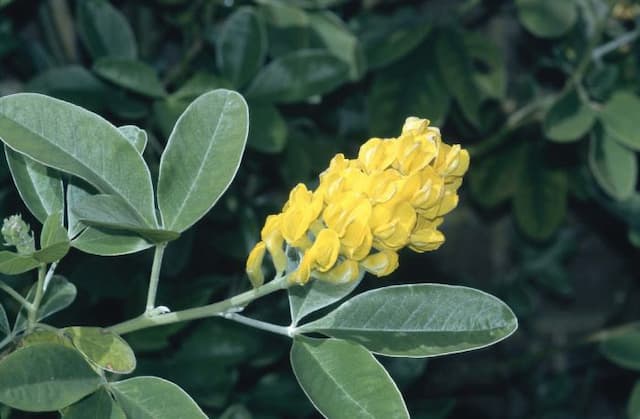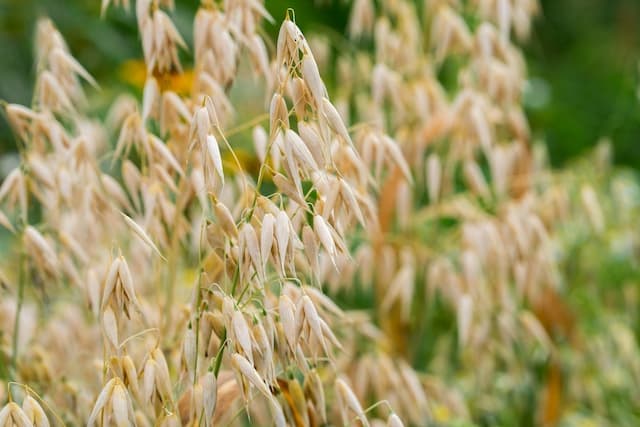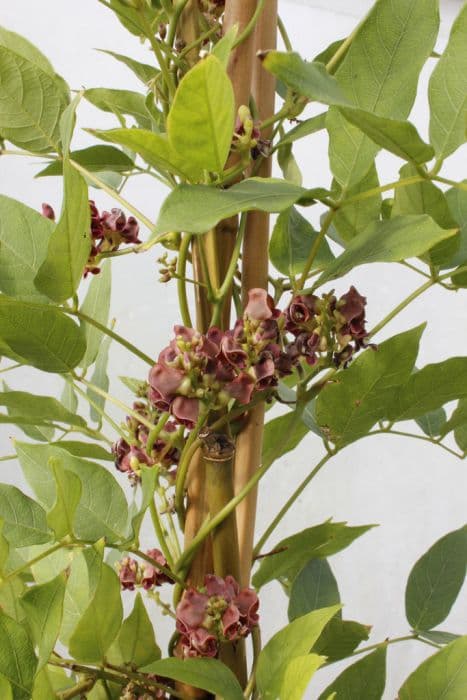Japanese Wisteria Wisteria floribunda

ABOUT
Wisteria floribunda, commonly known as Japanese wisteria, is a highly ornamental plant recognized for its beautiful cascading flowers. This climbing vine is famed for its spectacular and dreamy floral displays that drape elegantly from its vigorous stems. The flowers are the most striking feature of the Japanese wisteria, typically appearing in long, pendulous racemes that can be up to half a meter in length. Each cluster is densely packed with sweet-scented, pea-like blossoms, presenting a lavish array of colors ranging from purple and violet to shades of pink and white. The blossoms of Japanese wisteria emerge all at once, creating a breathtaking exhibition of color and fragrance in the spring. Their abundance can completely cover the vine, providing a rich visual feast. The leaves of the Japanese wisteria add to its attractiveness with their delicate, pinnate shape that creates a light, feathery canopy. Each leaf is made up of numerous, small, oblong leaflets, which are bright green and provide a fresh contrast to the rich floral tones. As Japanese wisteria matures, its woody stems twist and turn, developing into a thick, gnarled trunk that furthers the plant's elegant and rustic appeal. Its bark is usually grayish-brown, providing a beautiful texture and sturdy support for the prolific vine. Despite the exclusion of specific measurements, it is notable that Japanese wisteria can develop into a formidable and robust presence over time, capable of blanketing the structures it climbs with a profusion of flora. After flowering, Japanese wisteria produces elongated seed pods that mature to a velvety, dark brown hue. The pods persist into the winter, adding an element of interest to the plant even when it is not in bloom. Overall, Japanese wisteria is celebrated for its enchanting beauty and its ability to create a dramatic and delightful spectacle in the landscape.
About this plant
 Names
NamesFamily
Fabaceae.
Synonyms
Japanese Wisteria, Floribunda Wisteria.
Common names
Glycine floribunda, Kraunhia floribunda, Millettia floribunda, Rehsonia floribunda, Wistaria floribunda.
 Toxicity
ToxicityTo humans
Japanese Wisteria is known to contain toxic compounds that can be harmful to humans if ingested. All parts of the plant, particularly the seeds and pods, contain substances such as lectin and wisterin, which can cause poisoning. Symptoms of Japanese Wisteria poisoning may include nausea, vomiting, stomach pain, and diarrhea. In severe cases, other symptoms such as dizziness, confusion, or collapse may occur. It is important to avoid ingesting any part of this plant and to seek medical attention if poisoning is suspected.
To pets
Japanese Wisteria is toxic to pets, including dogs and cats, if ingested. The seeds, pods, and other parts of the plant contain compounds like lectin and wisterin, which can lead to poisoning. Symptoms of toxicity in pets can include vomiting, diarrhea, depression, and in severe cases, there may be confusion, weakness, and seizures. If you suspect your pet has ingested Japanese Wisteria, it is crucial to seek veterinary care immediately to address the potential poisoning.
 Characteristics
CharacteristicsLife cycle
Perennials
Foliage type
Deciduous
Color of leaves
Green
Flower color
Varies
Height
30 feet (9 meters)
Spread
30 feet (9 meters)
Plant type
Climber
Hardiness zones
5
Native area
Japan
Benefits
 General Benefits
General Benefits- Aesthetic Appeal: Wisteria floribunda, commonly known as Japanese wisteria, is highly valued for its cascading clusters of fragrant, violet-blue flowers that add significant beauty to any landscape.
- Shade Provider: Its dense foliage and fast-growing nature make it an excellent choice for creating natural shade over pergolas, arbors, and other garden structures.
- Habitat for Wildlife: The plant offers nectar for pollinators such as bees and butterflies, enhancing biodiversity in the garden.
- Erosion Control: The robust root system of Japanese wisteria helps stabilize soil, making it beneficial for controlling erosion on slopes and banks.
- Privacy Screen: With its dense growth, it can be trained along fences or trellises to create a living screen that adds privacy to a garden space.
- Seasonal Interest: It provides visual interest throughout the seasons, with attractive foliage in spring and summer, and textured seed pods in the autumn and winter.
 Medical Properties
Medical Properties- Anti-inflammatory: Wisteria floribunda may have compounds that can help in reducing inflammation in the body, although specific use and efficacy are not well-documented.
- Antioxidant: The plant may contain antioxidants that help in protecting the body from oxidative stress caused by free radicals.
- Hepatoprotective: Some studies suggest that Wisteria floribunda may offer protective effects for the liver, although research is limited and more evidence is needed.
 Air-purifying Qualities
Air-purifying QualitiesThis plant is not specifically known for air purifying qualities.
 Other Uses
Other Uses- Wisteria floribunda can be used in bonsai creation, providing a miniature, yet majestic version of the plant for enthusiasts to cultivate and enjoy.
- The robust vines of Wisteria floribunda are strong enough to be used as natural ties in the garden, supporting other plants or garden structures.
- When dried and treated, the wood of Wisteria floribunda can be used to craft small items, such as carving utensils or decorative objects.
- The plant has been traditionally used to make a natural brown dye, which can be used in textiles or art projects.
- Landscape artists use Wisteria floribunda as living curtains by training the vines over pergolas or arbors, creating shaded, floral canopies.
- The seeds of Wisteria floribunda have been used in jewelry-making, especially as beads, after they have been properly treated to remove toxicity.
- The fibers from the vines of Wisteria floribunda can be woven into baskets, adding an artistic touch with their natural texture.
- Gardeners may use the dense foliage of Wisteria floribunda as a privacy screen, effectively blocking out unwanted views with its thick leaves and flowers.
- Wisteria floribunda can serve as a natural sound barrier when planted densely, helping to dampen noise pollution in busy areas.
- As a component in perfumery, the fragrance of the Wisteria floribunda flowers can be captured and used to create scents that mimic the plant’s natural aroma.
Interesting Facts
 Feng Shui
Feng ShuiThe Japanese Wisteria is not used in Feng Shui practice.
 Zodiac Sign Compitability
Zodiac Sign CompitabilityThe Japanese Wisteria is not used in astrology practice.
 Plant Symbolism
Plant Symbolism- Longevity and Immortality: The wisteria plant is known for its ability to live for many years, often outliving those who plant it, symbolizing enduring life or immortality.
- Patient Love: Wisteria takes time to bloom, and can often take years before it first flowers, representing the virtue of patience and the reward of long-held affection.
- Welcoming: In Japanese tradition, wisteria is often planted at the entrance of a home, signifying the welcoming of guests.
- Good Luck: Especially in East Asian cultures, wisteria is believed to bring good luck to those who encounter it.
- Youth and Vitality: With its lush and vigorous plant growth, wisteria symbolizes the vigor and vitality of youth.
- Release of Burdens: The cascading blossoms of the wisteria can represent the flowing away of burdens, leading to a release of past woes.
- Creativity: The intricate and expansive nature of its vines suggest an affinity with creativity and the blossoming of ideas.
- Expansion and Exploration: As wisteria vines stretch out widely, they can signify the idea of expansion, such as broadening one's horizons or exploring new areas of life.
 Water
WaterJapanese wisteria requires deep watering, especially during the growing season, to ensure adequate soil moisture. The soil should be kept moist but not soggy; water the plant once a week with approximately 1 to 2 gallons per plant, adjusting for rainfall, heat, and soil type. During hot, dry periods, watering frequency may increase to twice a week, while in cooler months or during rainfall, reduce watering accordingly. Overhead watering should be avoided to prevent leaf disease; instead, water at the base of the plant.
 Light
LightJapanese wisteria thrives in full sun, requiring at least six hours of direct sunshine daily to bloom well. The best spot for this climbing vine is in an open area where it can receive unobstructed sunlight, either on a trellis or wall that faces south or west for optimal exposure.
 Temperature
TemperatureJapanese wisteria is hardy and can withstand a wide range of temperatures, growing best between 60 to 80 degrees Fahrenheit. It typically survives winter in USDA zones 4 through 9, which means it can handle minimum winter temperatures of -30 to -20 degrees Fahrenheit but may die back in colder climates.
 Pruning
PruningPruning Japanese wisteria is important to control growth, encourage flowering, and maintain a tidy shape. Prune in late winter to cut back the previous year's growth to a few buds, which stimulates the plant for spring blooming. Additional light pruning after flowering can help promote new buds. The best time for major pruning is late winter, but light pruning can be done after the blooming period in spring to summer.
 Cleaning
CleaningAs needed
 Soil
SoilJapanese Wisteria thrives in fertile, well-drained soil with a pH of 6.0 to 7.0. A good mix is loamy garden soil with compost and perlite to ensure proper drainage and fertility.
 Repotting
RepottingJapanese Wisteria should be repotted every 2 to 3 years to refresh the soil and manage its growth, less often as the plant matures.
 Humidity & Misting
Humidity & MistingJapanese Wisteria is tolerant of various humidity levels but thrives best in moderate ambient humidity, without special requirements.
 Suitable locations
Suitable locationsIndoor
Provide strong support, ample light, and prune to control size.
Outdoor
Plant in full sun, provide sturdy support, prune for shape.
Hardiness zone
5-9 USDA
 Life cycle
Life cycleJapanese wisteria (Wisteria floribunda) begins its life cycle as a seed, which after being dispersed, germinates in favorable conditions of soil and temperature. The seedling emerges and develops into a juvenile vine, which prioritizes growth over flowering, often for several years. During this vegetative stage, the plant focuses on establishing a strong root system and vigorous stems. Once mature, the vine enters the reproductive stage, characterized by the production of long, pendulous clusters of fragrant flowers in late spring to early summer. After the flowering period, the vine develops seed pods that mature over the summer and into fall, eventually releasing seeds to start the next generation. Over time, the plant can become quite large and woody, with some vines living and continuing this cycle for several decades.
 Propogation
PropogationPropogation time
Spring to early Summer
Wisteria, or more specifically Wisteria floribunda, also known as Japanese wisteria, is best propagated in late winter through hardwood cuttings, though they can also be started from seed. However, the most popular method is via softwood cuttings taken in the spring or early summer. To propagate using softwood cuttings, select a healthy, new growth shoot and cut a piece about 4-6 inches long. Remove the leaves from the bottom half of the cutting and dip the cut end into a rooting hormone. Then, plant the cutting in a moist, well-draining potting mix and cover with a plastic bag to create a mini greenhouse environment. Keep the soil consistently moist and in a warm, indirect light source until roots have developed, which is usually in a month or so. Once the cuttings are well rooted, they can be transplanted into the ground or into individual pots.









